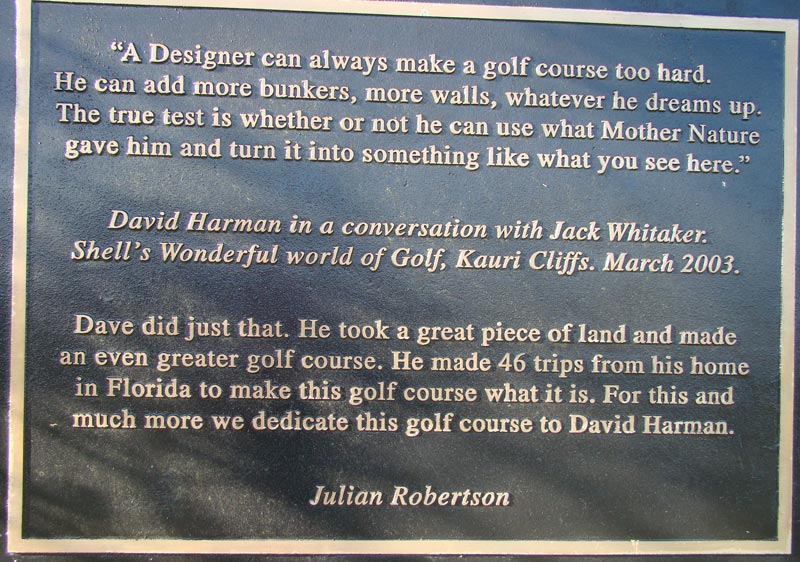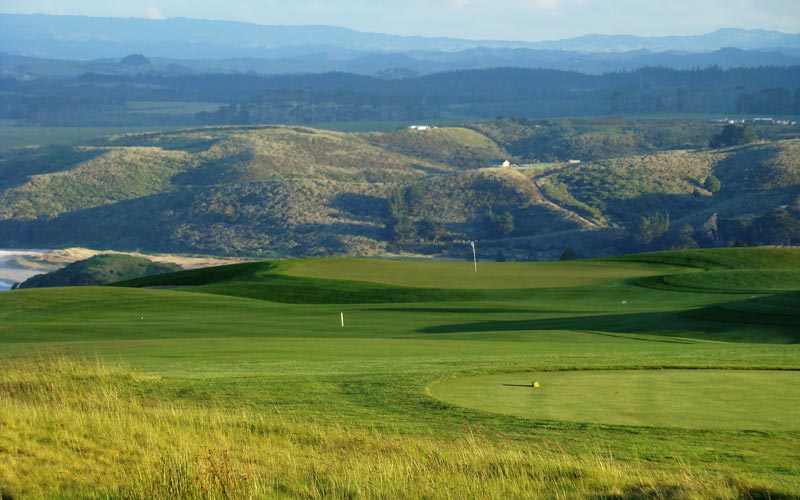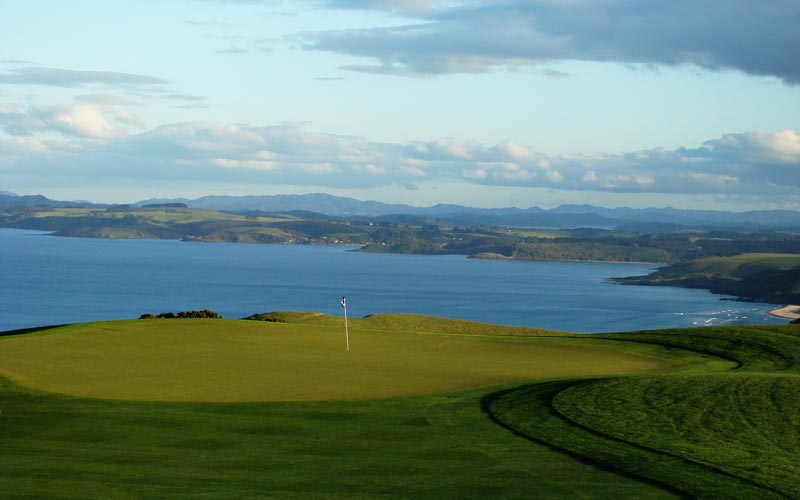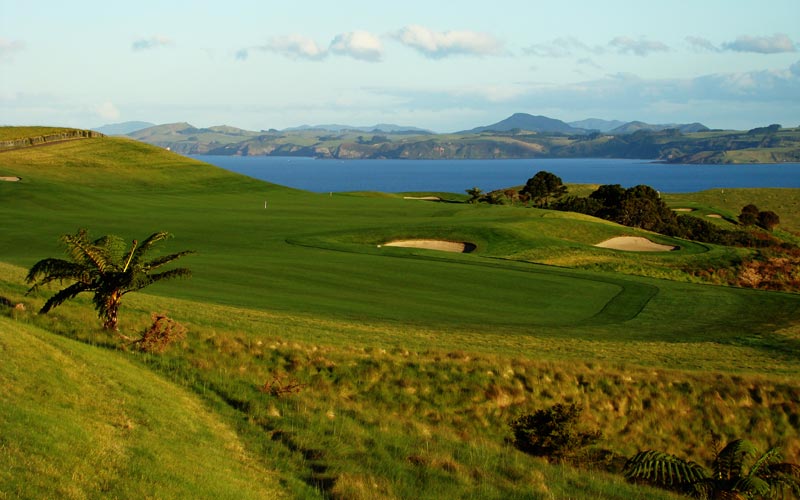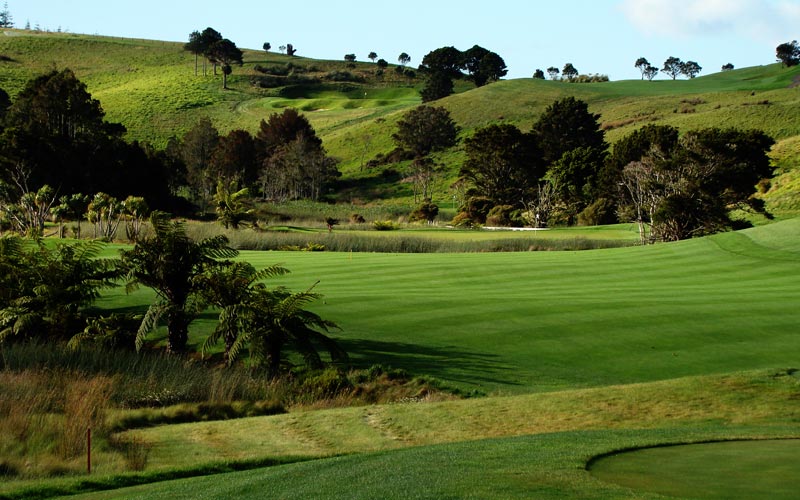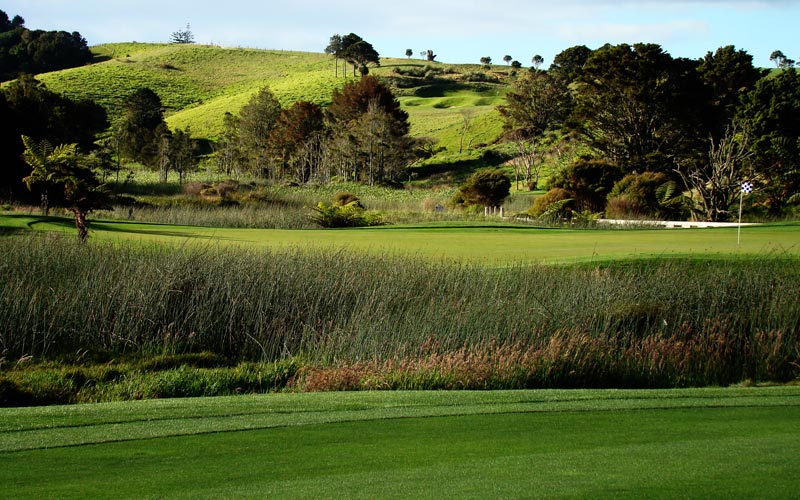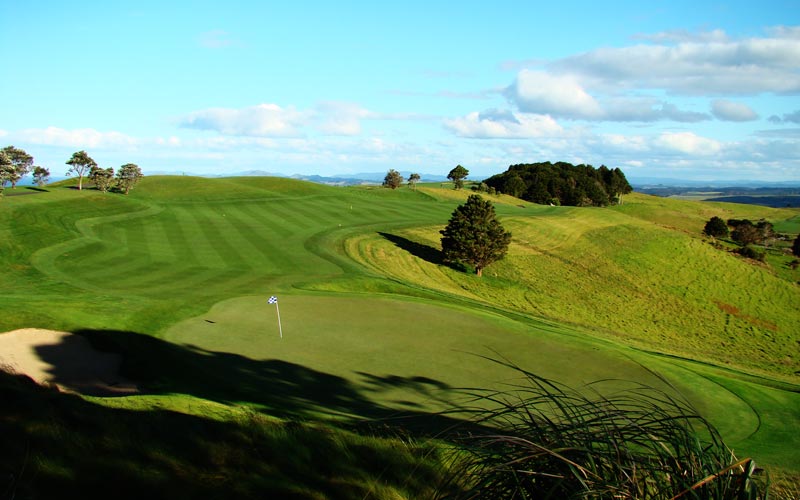Kauri Cliffs
Matauri Bay, New Zealand
Golf Course Manager: Andy Wood
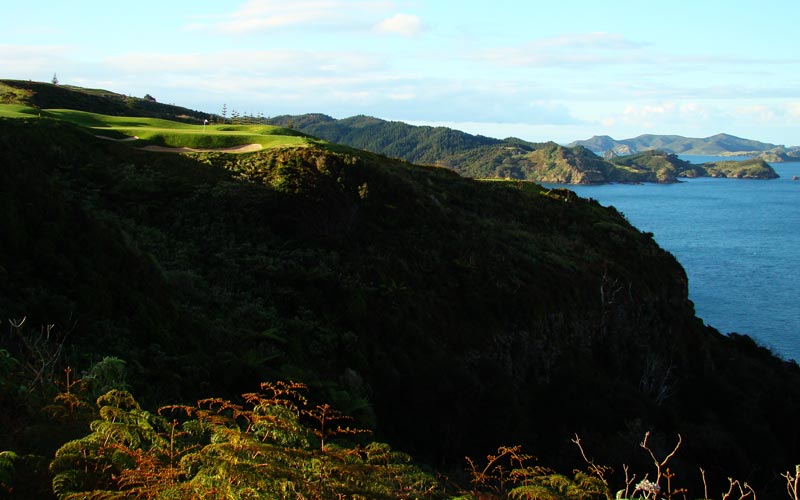
Though aerial photographs of Kauri Cliffs are quite striking, ones taken from the golfer’s perspective are just as compelling. Pictured above is the par three seventh green as seen from its tee.
The great chroniclers and architects of the game have long lauded the health benefits of golf. Bernard Darwin once noted, ‘There are consolations in being out in the open air, in the scenery and surroundings, in the absolute escape from mundane worries, in the jolly sporting spirit that blows over the links, and in the consciousness that by tomorrow one’s good shots will be remembered, one’s bad ones forgotten, and hope again in the ascendant. ‘ Dr. Alister Mackenzie famously wrote in Golf Architecture in 1920,
A good golf course is a great asset to the nation. Those who harangue against the land being diverted from agriculture and used for golf have little sense of proportion. Comparing the small amount of land utilised for golf with the large amount devoted to agriculture, we get infinitely more value out of the former than the latter. We all eat too much. During the Great War the majority were all the fitter for being rationed and getting a smaller amount of food, but none of us get enough fresh air, pleasurable excitement and exercise. Health and happiness are everything in this world. Money-grubbing (so called business), except so far as it helps attain these, is of minor importance. One of the reasons why I , “a medicine man,” decided to give up medicine and take to golf architecture was my firm conviction of the extraordinary influence on health of pleasurable excitement, especially when combined with fresh air and exercise. How frequently have I, with great difficulty, persuaded patients who were never off my door-step to take up golf and how rarely, if ever, have I seen them in my consulting rooms again!’
What the game does to the human spirit by refreshing and reinvigorating the soul surely is at the heart of the game’s enduring core. To that end, where the game is played matters greatly. The better the setting and the better the architecture, the higher the spirit soars (or at least so this web site contends). To that end, in all the world, there are few if any places that possess the kind of beauty that Kauri Cliffs does and the human spirit rejoices like nowhere else. Fifteen of the holes afford sweeping vistas of the Pacific Ocean while the remaining three drop into a valley and play alongside a marsh. Sheep dot the valley walls and are no doubt impressed by how well you are playing, though they hide it well. Of the fifteen holes played on the higher land, six are directly along the cliff line and indeed the best holes play over the cliff line.
Obviously, there is no substitute for great property but there is great property (including soil) for golf (Royal Lytham & St. Annes, Kingston Heath, Carnoustie, and Newcastle in Australia) and then there is great property for golf with long views (Sand Hills, Cypress Point, Pacific Dunes and Jasper Park). Kauri falls in the latter category. Still, even great property with long views isn’t enough if the owner or the architect somehow inserts themselves too much into the picture. For instance, owners frequently mandate that a portion of prime property be held back for real estate. Most emphatically, that was not the case here where owner Julian Robertson’s sole objective was for the best possible course to be yielded from the 4,500 acres that he initially purchased in 1997. Not only was the entire 2,600 yards of shoreline at architect David Harman‘s disposal but the closest man-made structures were set back over 500 yards from the cliffs and they were the clubhouse and eleven outlying cottages snuggled at the edge of a totora forest. Generations of golfers win by the fact that Mr. Robertson had the wherewithal not to worry about real estate and Kauri Cliffs is a rare instance in the modern game where the best land was truly and wholly devoted to golf.
Given this dream combination of property and owner, it came down to the architect. After numerous visits to the site from his Orlando, Florida office, David Harman finally determined a routing that maximized the jagged cliff line and carefully found a way to place each type hole (i.e. a par three, par four, and par five) along the property’s most spectacular sections. On the front nine, the par three seventh provides one of the game’s indelible memories while the reachable par five fifteenth and drivable par four sixteenth tempt the golfer into all kinds of poor decisions on the back. Even its sister resort course at Cape Kidnappers in Hawke’s Bay doesn’t afford such moments of hitting out and over the cliff line and these kinds of shots compel golfers to travel to Auckland and then make their way 160 kilometers to the north to Kauri Cliffs.
A native of the Buckeye state, David Harman‘s first introduction to golf course construction was through a summer job with Nicklaus Design in the late 1970s. When the six foot six inch tall, three hundred pound David Harman injured his knee, he realized his dream of playing for Woody Hayes at The Ohio State University was over. Instead, he continued working during the summers and after graduation for Nicklaus. In 1980, he started his own golf course construction company, and much of his earlier work was for Arnold Palmer. A warm engaging bear of a man, David Harman devoted two years of his life to the design and construction of Kauri Cliffs, which opened in February, 2000. For his part, Mr. Robertson very much enjoyed his interaction with David Harman throughout the process.
Kauri Cliffs would have done for David Harman what Pacific Dunes did for Tom Doak’s career, which is to say that it would have propelled him to many other exciting projects. Sadly, David Harman developed throat cancer after Kauri Cliffs opened and passed away December 28th, 2007 at the age of fifty-one. The golf world will never know what else he had to offer.
Yardage is only a relative measurement in an environment such as this one whereby the wind changes the nature of the holes on a daily – or even hourly – basis. From the back markers, don’t let the views on this 7,100 yard plus course fool you: Kauri Cliffs is a rigorous test. Camilo Villegas remarked as such. After the 2009 Kiwi Challenge that was contested at Cape Kidnappers, he flew up with Mr. Robertson to experience Kauri Cliffs for himself. Playing in windy conditions, he made a point to say how stout the shot requirements are – and this from a man who can flight the ball at will. Fortunately, the middle tees are some 600 yards forward and both the blue and white marker distance are given below.
Holes to Note
First hole, 440/420 yards, Takou; When most people think of playing golf by the sea, they first think of the United Kingdom. Ironically, the biggest landforms there are typically the dunes right along the coastline. Thus, though the golfer is near water, he rarely sees it during his round. This is not true here and though the first hole at Kauri Cliffs is the farthest point from the water, it is also the high point on the course, providing broad views across the course and out to the Pacific. In so doing, it admirably sets the tone for the round.
Fourth hole, 560/520 yards, Cambo; Kiwi Michael Campbell is so enamored with this risk/reward three shotter that the resort kindly re-named it in honor of the 2005 U.S. Open Champion. Of the design elements at Kauri Cliffs, David Harman‘s love of half par holes is perhaps what shines through the most. Be it here, some of the death or glory one shotters, the drivable tenth and sixteenth, or the reachable fifteenth, David Harman provides plenty of opportunities whereby the golfer needs to decide whether to thrust or parry.

The last 100 yards of the fourth bends right around a fall-off and it is the courageous man who can slot his second shot along the fairway and onto the green.
Fifth hole, 200/160 yards, Boomerang; The five sets of tees at Kauri Cliffs allow the course to play anywhere from just under 4,900 to over 7,100 yards. Starting here, the golfer will firmly appreciate if he has selected the correct set of tees given his game and the day’s playing conditions. Over the next ten holes, he will play four par threes and they all will tax his ability to flight the ball through the wind a prescribed distance. Short is rarely an option.
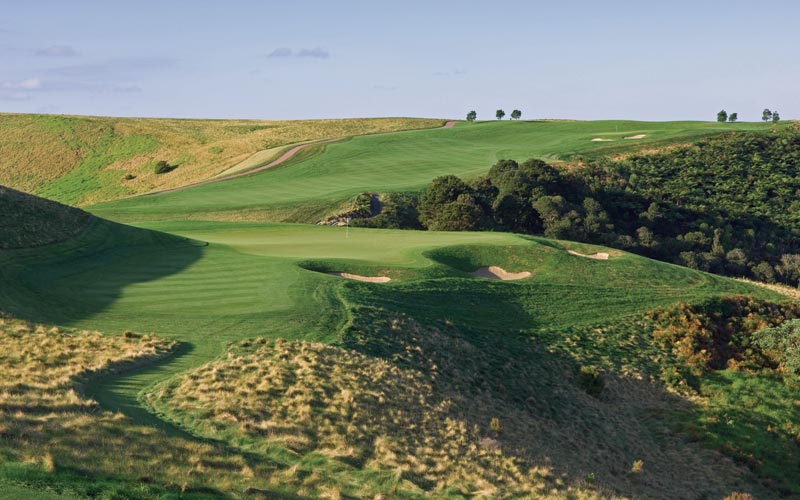
Photographer Joann Dost provides this perspective as to how Harman routed the fifth around the rim of the gorge. The different sets of tees provide an appropriately wide range of playing angles to accommodate the resort play with the long, all-carry shot from the back markers being the most daunting.
Seventh hole, 220/175 yards, Cavalli; Though all the one shotters are demanding, that is not to say that David Harman doesn’t help the golfer. In order to get the optics right from the tee, David Harman bowled out the setting for the seventh putting surface and Green Keeper Andy Wood carefully maintains the turf in a tight manner so that golfers can use the left and back banks to find the putting surface. A relentless series of raised greens that shed golf balls would wear down most golfers in such a windy environment and the fact that David Harman provides a green with gathering qualities at the course’s most dramatic point is a fine touch. Nonetheless, Darwin’s words of ‘the problem of dispatching that insolent ball in the desired direction suddenly becomes quite terrifying’ never have rung more true than as one stands on the precipice and looks at the task ahead. David Cannon’s newly revised Golf Course book features this green for its striking dust jacket.
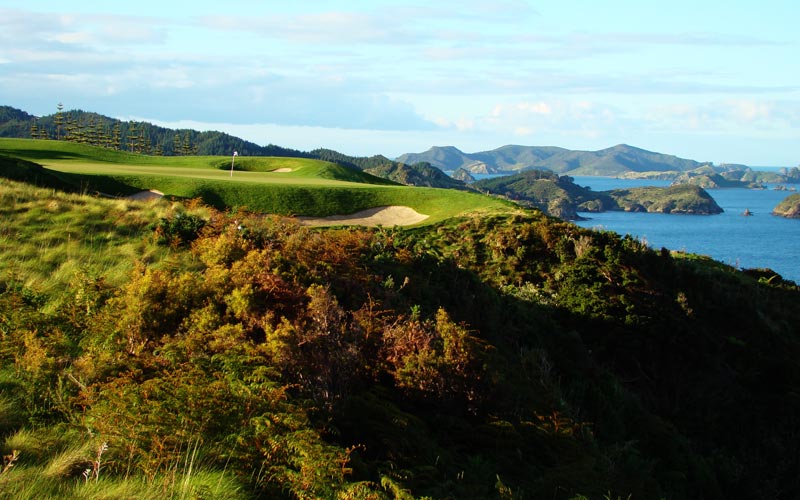
The traveling golfer is not likely (!) to be reminded of one his course’s par threes back home when he stands on the seventh tee. When the northern hemisphere is cold and dreary, there are few spots the golfer would rather find himself than here with miles of uninterrupted views of the Cavalii Islands. In fact, don’t forget to turn around for captivating views of Pink Beach in the other direction.
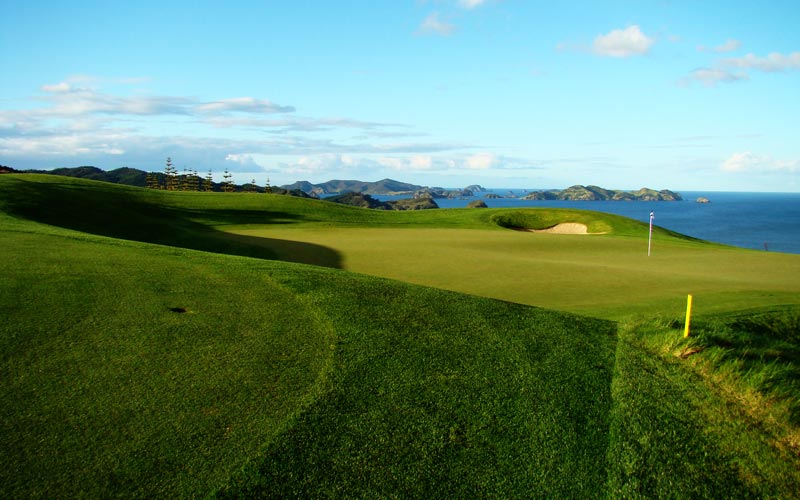
Harman bowled out the area for the seventh green and golfers can use the bank (well away from the cliffs) to kick balls onto the putting surface.
Tenth hole, 365/345 yards, Valley; The golfer has mostly played along the tops of ridges and up and down valleys that afford views of the Pacific Ocean. The tenor of the course now changes for the next four holes with this tee ball as the golfer is dropped some fifty feet down into a valley. The golfer has two things in his favor at this point. One is that he is sheltered – at least relatively speaking – from the wind and the other is that the stances that he will draw in the fairways are among the most level on the course. The downside is that marshland is now introduced as a hazard, so the requirement for good ball striking remains high.
Eleventh hole, 420/385 yards, Totara; Just a few holes ago the golfer was hitting a do or die tee ball over an abyss at the seventh and now he finds himself in a serene valley with sheep baa-ing on the hillside. Both settings are beautiful in their own right but to find them on the same course in such a short time span is a unique attribute.
Kauri Cliffs
Matauri Bay, New Zealand
Thirteenth hole, 425/405 yards, Tablelands; Just as at Cape Kidnappers, the cliff side holes hog the notoriety and that will never change but it does mean that golfers will always be pleasantly surprised when they come across an inland hole of as high a quality as this one that they have never heard about. Its golf qualities are just as good as the cliff side holes though you may never see photographs of it elsewhere (other than here of course!). After finding the elevated level of the fairway with his tee ball, the golfer mulls over how best to approach the green that is set on an angle to the fairway. Guess wrong and come up short and the golfer likely will face a bunker shot from either of the two deepest greenside bunkers on the course.
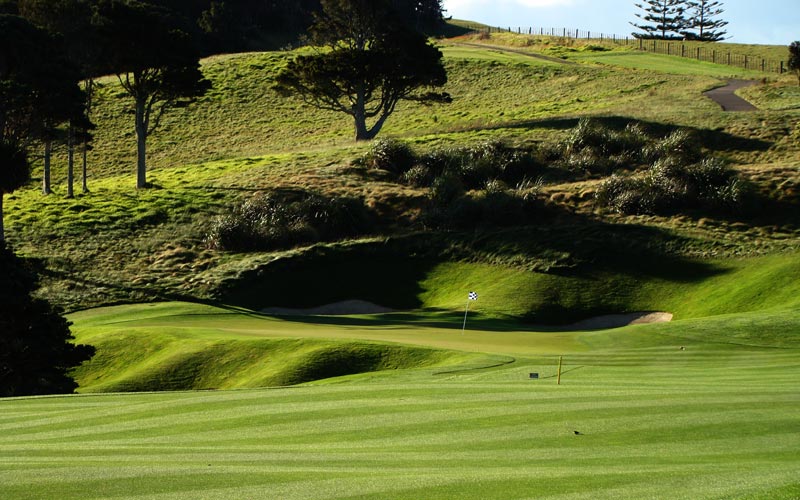
One of the best set-up approach shots on the course comes at the thirteenth where Harman benched a fairway into the hillside and had it turn around an elbow.
Fourteenth hole, 230/175 yards, Waiaua Bay; Back in the 1950s and 1960s when the C.I.A. was a bastion for the best from the Ivy League schools, the first question applicants would be asked is what club does one use on the thirteenth tee at National Golf Links of America. Such a question was meant to sort quickly through who was made of the right stuff. The ‘right’ answer was supposedly a seven iron but the real right answer would have been to first ask back which direction and what strength was the wind blowing. Such is true here as it ask what club one hits here is meaningless as the fourteenth tee marks the highest spot on the course and as such, the full effects of the wind are felt on this tee. Having holed out at the thirteenth which borders farmland, the golfer makes the uphill walk toward to the fourteenth tee and the first time visitor is shocked when he crests the hill. With no hint being given from the prior hole, the glories of Kauri Cliffs’ coastal setting come into full view. These next four holes are as well situated as any in golf and the diversity among them (a par three, a par five, a reachable par four, and a brute of par four) is top draw.
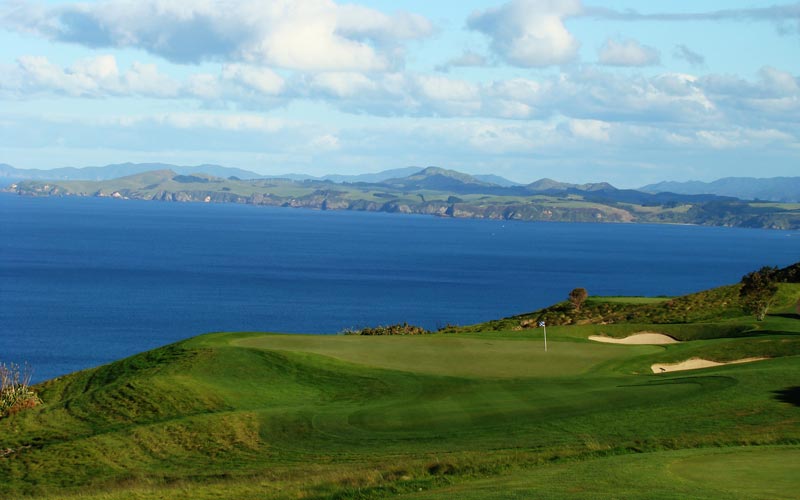
The golfer is reintroduced in dramatic fashion to the cliff line at the fourteenth. Given the sharp fall off left of the green, today’s right to left wind poses a dilemma. A draw can quickly turn into a hook and conversely, a shot cut back into the wind is beat down. Though the par three holes make stringent demands, the nonpareil views afforded from them offer consolation.

Joann Dost’s stunning aerial shows the dogleg left thirteenth hole in the bottom right and the fourteenth in the bottom left, which starts the journey home along the cliffline. As this aerial proves, the best land was indeed set aside for golf. Home sites were in no way a consideration and Harman took advantage of this luxury by using the coastline to maximum advantage.
Fifteenth hole, 545/515 yards, Cook’s Hook; Despite the breathtaking vista of Waiaua Bay below and the Cavalli Islands in the distance, the golfer is asked to concentrate and hit one of the most taxing tee shots of the day along the edge of a cliff wall covered in native vegetation. Anything hit left falls off the world, which is unfortunate as that can spoil the walk along the four hundred yard long fairway which provides the best opportunity on the course to slow down and fully appreciate just where one is. Even the most jaded traveler will marvel taking in the uninterrupted 180 degree views of nothing but nature at her pristine finest. Never has the person been so glad as to be a golfer as without the game, he would unlikely find himself in such an environment. The spirit rejoices and the mind swirls, perhaps thinking of Zane Grey and the great marlins and swordfish in the waters below or of taking an excursion to the hole in the rock at Cape Brett in the distance. The bottom line: The mind happily boggles as to where the body is.
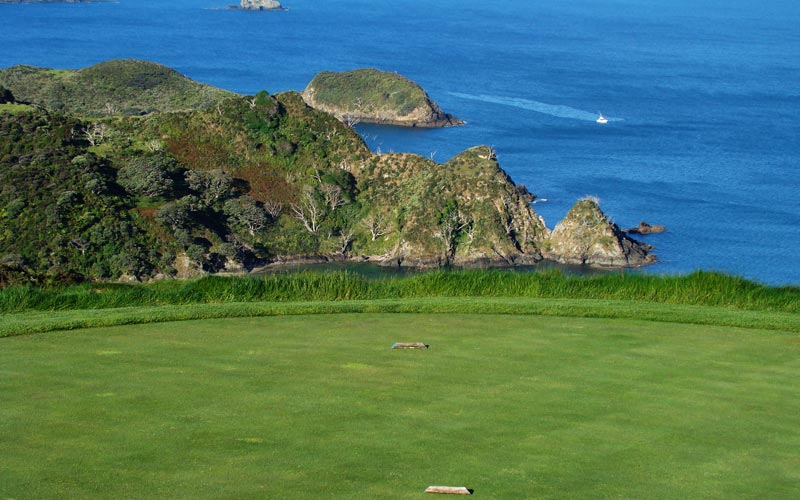
Views such as this one past the fifteenth tee add immeasurably to the enjoyment of both the game and of being alive.

This view down the hole from the fifteenth tee isn’t bad either and it certainly is enough to make many a good player’s swing become unglued. Only the bravest seek the left hand side of the fairway for a chance to have a go at the green in two.
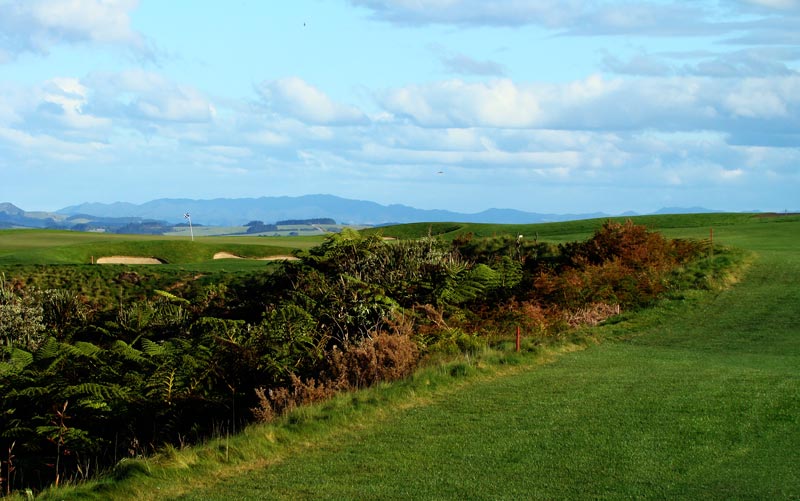
For those that can’t reach the green, the best lay-up is long down the right as the green opens up from the outside of the dogleg. From this spot 110 yards short of the green in the left rough, the approach is all carry and the angle is terrible.
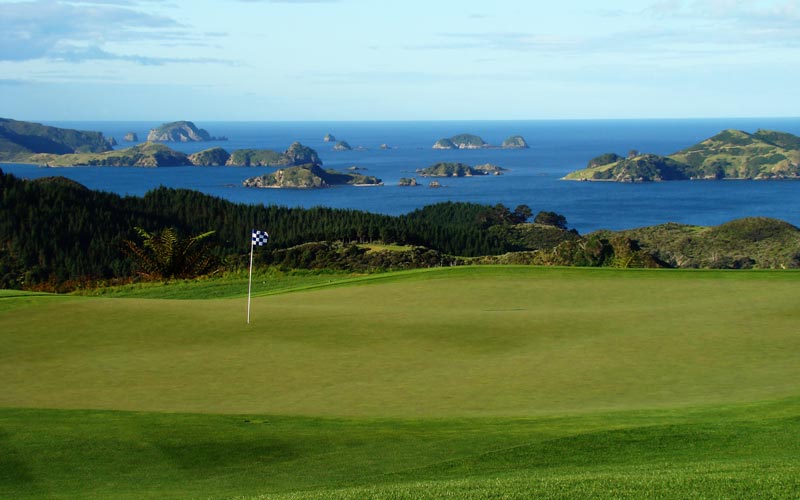
Just getting near the fifteenth green in two doesn’t guarantee a birdie as the contours within the green offer several difficult hole locations, including the one above. Of course, if you first studied the intricacy of the green when you saw this photograph, then something is the matter!
Sixteenth hole, 365/355 yards, Temptation; Some resorts stick with the same architect such as Pinehurst Resort and Tom Fazio and Kohler and Pete Dye. This is patently not the case at Kauri Cliffs and Cape Kidnappers as David Harmon’s and Tom Doak’s architectural styles could not be more diverse. One way that manifest itself is in the bunker construction. As seen in Cape Kidnappers’ profile found on this web site, the bunkers were cut into landforms and are generally below the natural grade of the land. As seen above, Harmon’s bunkers stick up more and hide the sixteenth fairway as it doglegs left and tumbles toward the sea. Some players prefer Doak’s style while others like Harmon’s more – and that is great. After all, most guests fly a long way to play both courses and to have them be same-same would be ludicrous. Remember: Pebble Beach and Bandon are the two most profitable golf resorts in the world and they both feature disparate forms of architecture, much to everyone’s ongoing delight.

Harman’s fairway bunker walls rise up and hide most of the sixteenth fairway as it sweeps downhill right to left toward the green. However, just because the fairway is out of sight doesn’t mean that strategic options don’t exist as to how to play the tee ball.
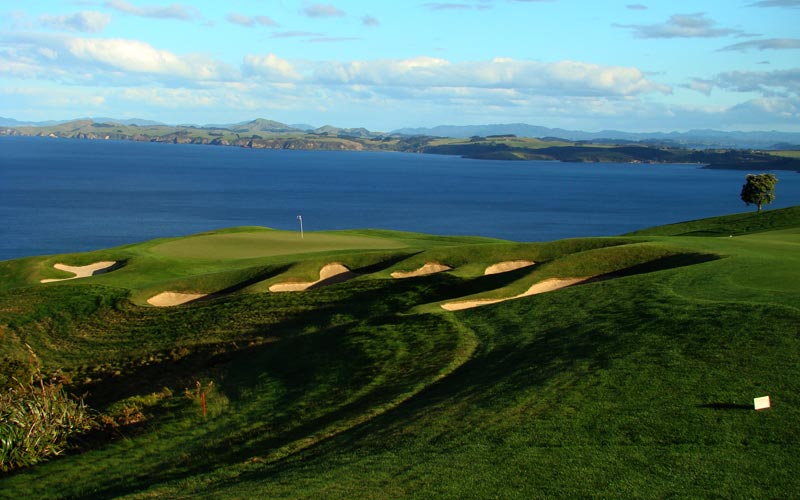
As seen from the crest of the hill 100 yards before the green, Harman built a plateau in the green in part to help brake tee balls from golfers like Adam Scott who reached this green with a three wood during the 2008 Kiwi Challenge.
Seventeenth hole, 470/440 yards, Rainbow; Several of the world’s greatest holes play from an elevated tee to a fairway set on an angle. Two prime examples are the fifth at Royal Portrush and the sixth on the West Course at Royal Melbourne. A similar opportunity was presented in spades here and Harman seized the moment to create what many consider to be the best hole on the course. Unlike the holes at Portrush and Royal Melbourne, if ever a golfer wishes that his natural shape shot is a draw, it is standing on this elevated tee as he loves nothing more than to turn over his tee ball and watch it follow the shape of the fairway and bound along.
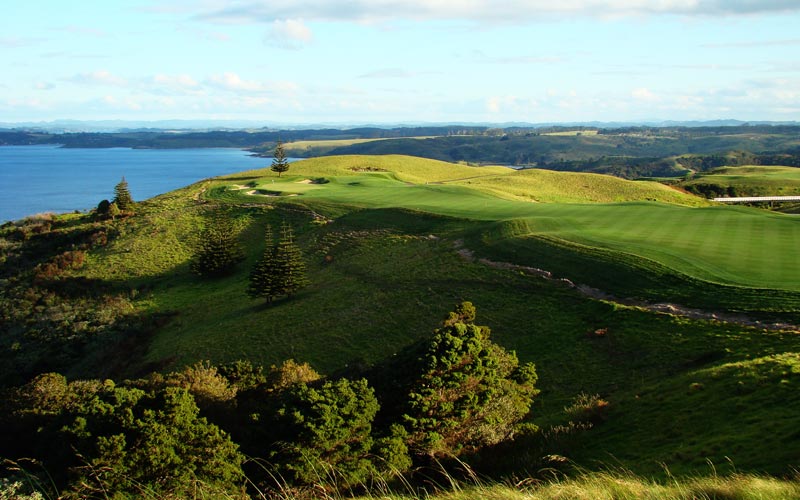
Depending on the golfer’s state of mind, he will either bask in the challenge presented off the seventeenth tee or feel dwarfed by the scale of his surrounds.
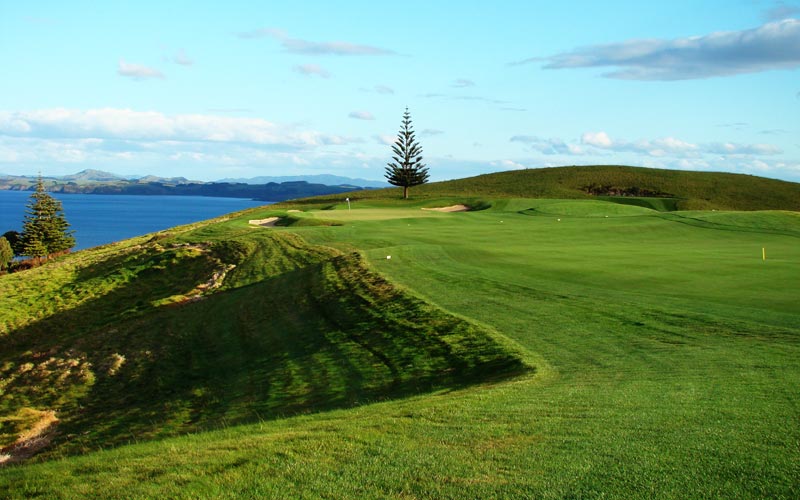
Appreciating that many approach shots would be played from a long way out, Hammond left the front right of the green open and approach shots that land short frequently get favorable bounces onto the putting surface.
As with other famous courses beside large bodies of water such as Bandon Dunes, Whistling Straits, and Tralee, there is a sense of regret when one leaves the water and the last hole for each nine heads back to the clubhouse. Same is true here but here at least the tee shots have to clear a ravine and the golfer remains fully engaged. Yes, the valley wall on the far side is too abrupt to constitute great golf but the reward is the views afforded from the clubhouse’s porch.
In addition to leaving behind Kauri Cliffs and Cape Kidnappers, Mr. and Mrs. Robertson are donating their art collection to the Auckland Museum upon their passing away. There is no telling how being exposed to Van Gogh or Rembrandt or Monet will influence the youth of New Zealand. However, what is undeniable is that by sharing these works of art in a public setting, their impact will be all the greater. The same is true with the resorts of Kauri Cliffs and Cape Kidnappers as they bring people to these two special places whereby guests are immersed in the best that nature has to offer. Where else can you go on a night tour for kiwis or see Tane Mahuta (the world’s largest Kauri tree) or go see the largest gannet colony? As Darwin and MacKenzie would argue, these properties and their impact on the human spirit are just as strong as the works of art on canvas.
There is one difference though. Unlike the century old pieces of art of which the Robertsons have been good stewards, the Robertsons drove from scratch the creation of the two works of art at Kauri Cliffs and Cape Kidnappers. Sir Edmund Hillary was the last ambassador of goodwill to this extent that New Zealand has seen and the country will be forever grateful for the Robertson’s lasting legacies.
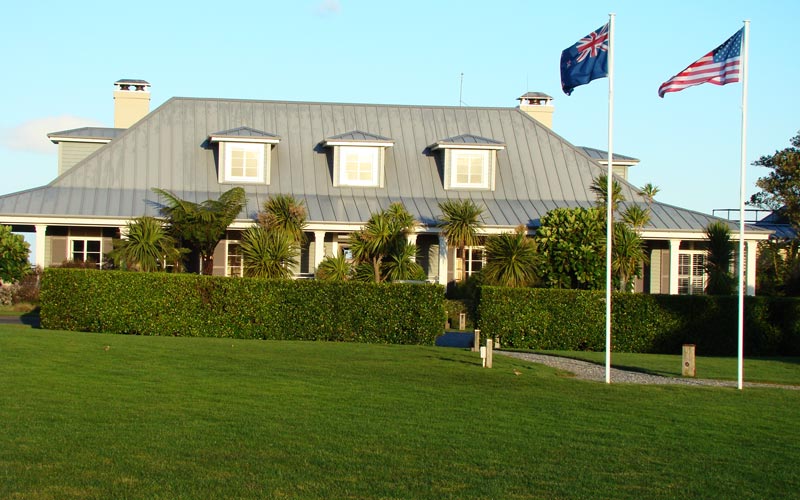
The New Zealand and American flags are on proud display in front of the clubhouse. Travelers to this majestic part of the world will forever appreciate what Julian and Josie Robertson have created.
The End


